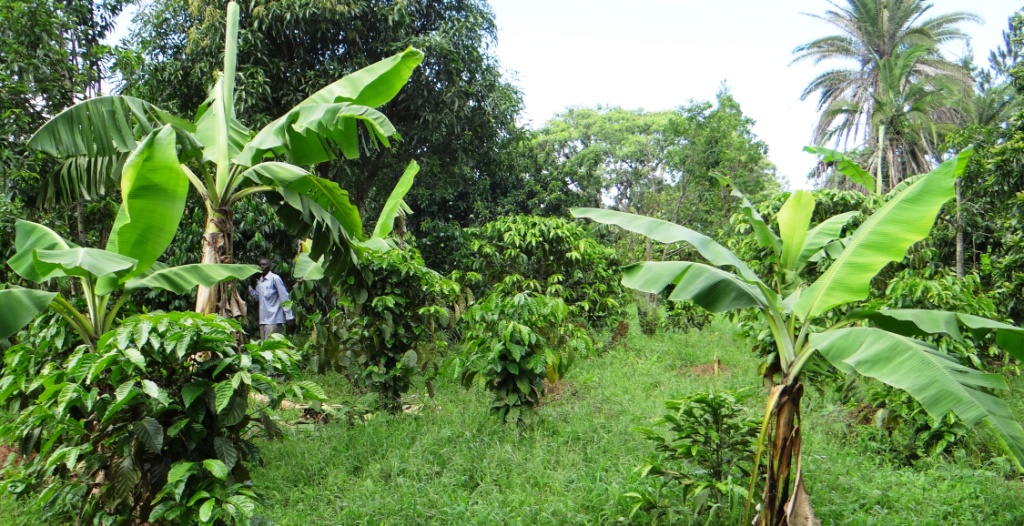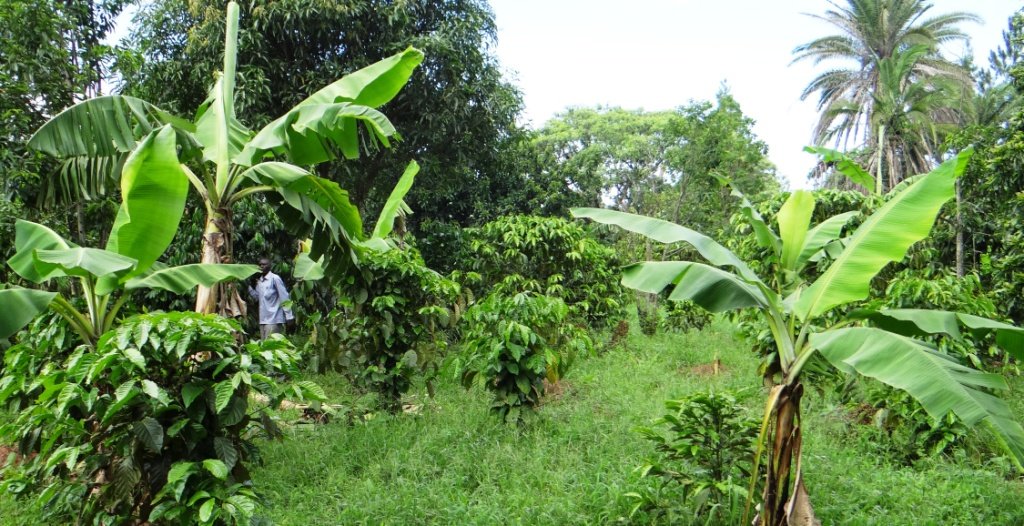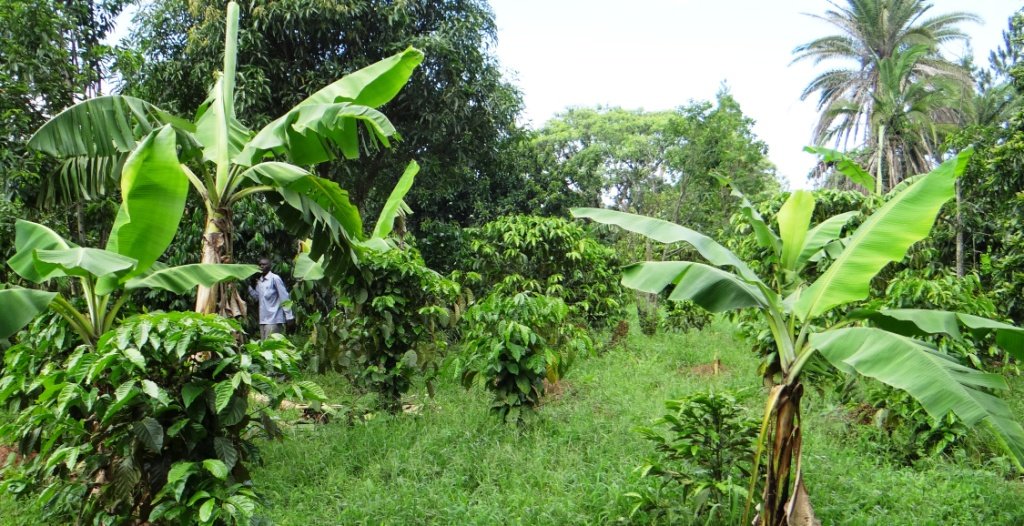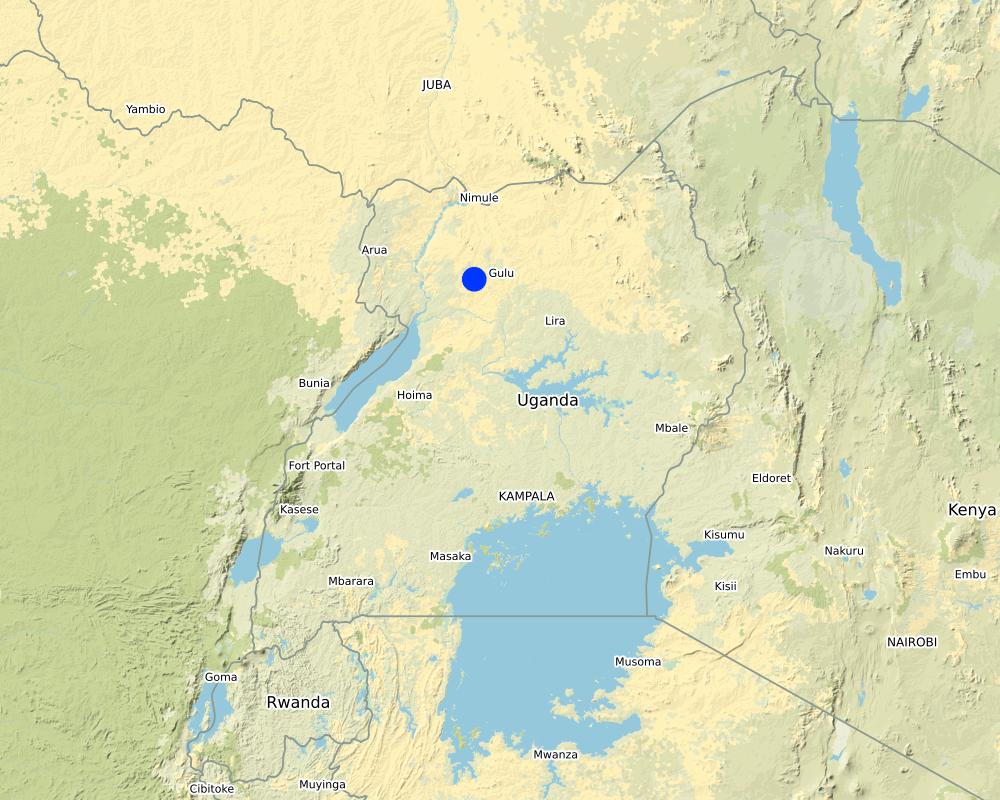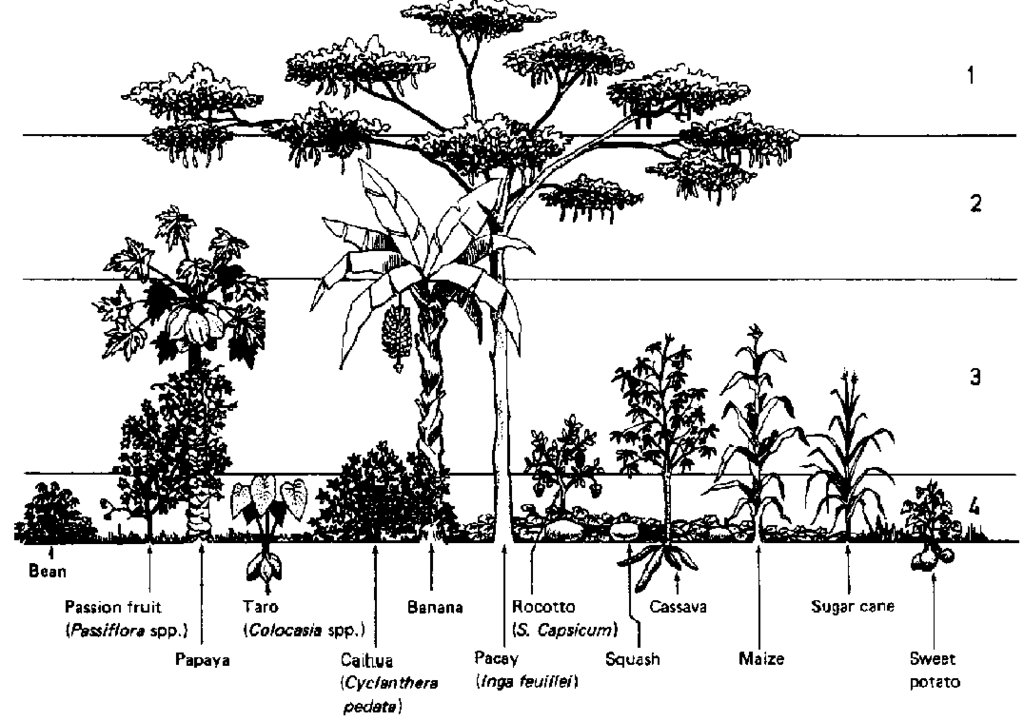Multi-Canopy Agroforestry [乌干达]
- 创建:
- 更新:
- 编制者: Bernard Fungo
- 编辑者: JOY TUKAHIRWA, Kamugisha Rick Nelson, betty adoch, Sunday Balla Amale
- 审查者: Drake Mubiru, Nicole Harari, Udo Höggel
Pito Yen Ki Labolo Ki mwanyi Ka ngig yat mapatpat
technologies_2148 - 乌干达
查看章节
全部展开 全部收起1. 一般信息
1.2 参与该技术评估和文件编制的资源人员和机构的联系方式
关键资源人
土地使用者:
Otto Bosco
+256773392188
Omoro District Farmers
Ongako sub county, Omoro District
乌干达
有助于对技术进行记录/评估的项目名称(如相关)
Scaling-up SLM practices by smallholder farmers (IFAD)有助于对技术进行记录/评估的机构名称(如相关)
Uganda Landcare Network (ULN) - 乌干达1.3 关于使用通过WOCAT记录的数据的条件
(现场)数据是什么时候汇编的?:
11/05/2017
编制者和关键资源人员接受有关使用通过WOCAT记录数据的条件。:
是
1.4 所述技术的可持续性声明
这里所描述的技术在土地退化方面是否存在问题,导致无法被认为是一种可持续的土地管理技术?:
否
2. SLM技术的说明
2.1 技术简介
技术定义:
Trees of various sizes are integrated with crops such as coffee and/or banana, maize and beans such that each group of plants occupies a specific vertical position and competition for vertical space is minimized
2.2 技术的详细说明
说明:
In multicanopy agroforestry, annual crops that include maize, beans and shrub species such Calliandra and Sesbania are integrated so as to occupy the lower vertical spaces. The next height is occupied by taller crops such as coffee, cocoa and bananas while the highest layer is occupied by tall trees such as Maesopsis eminii, Makhamia lutea and Ficus nantalesis. This arrangement ensures that as much land as possible is utilized.
The upper strata of a multi-layered planting is called the overstory, or canopy. The trees that make up this layer play the key role in creating the understory. The shady environment in the understory (i) Reduces evapotranspiration (evaporation of water through the leaves and branches of the plant), conserving moisture in the plants and reducing water use (ii) Buffers crops from temperature extremes and fluctuations (iii) Protects crops from winds (iv) Suppresses many invasive problem weeds, which tend to prefer open conditions and full sun and (v) Supports a range of beneficial soil microlife that do not thrive in the open. On the other hand, understory crops should (i) tolerate partial shade (ii) exploit, at least partially, different soil horizons than the overstory trees (iii) be less tall than the overstory trees when mature (although some trees may be planned to use the shade as seedlings, but eventually overtake and become part of the upper layer) (iv) be less susceptible than the overstory trees to diseases they may have in common and (v) not involve damage to the overstory trees during cultivation or harvest of understory crops. The most important consideration when implementing this technology is that the various components of the plant system have to be compatible.
Management should be done to reduce competition for vertical and horizontal space. The number of trees per acre is 50% less compared with timber or fruit trees planted alone. Spacing should be planned to provide the most optimal environment for the understory, and minimize competition for space, light, and nutrients. The species growth rate, rooting patterns, and other factors should be taken into account when planning.
Required management activities include weeding, pruning, and thinning. Weeding is usually done twice every season mainly to take care of the annual crops such as maize and beans. Pruning is done whenever the farmer sees that light intensity from the upper canopy is no longer enough to support the understory crops. Usually, once a year is appropriate. Pruning is also done to reduce the risk of old branches falling and damaging crops and other farm structures. Thinning is done to reduce the number of seedlings from the soil ground.
The technology increases biodiversity on-farm, and protects the environment from degradation, soil loss, and wind break. This diversity has the advantage of reducing pest and disease incidence. The mixed fruits and trees provide timber and fuel wood, shade for coffee and banana, and keep the soil moist. It also acts as wind break which protects crops, farm structures and reduce soil loss by wind. It is a source of income to land user, provides food, improves the ecosystem, and leguminous plants fix nitrogen in the soil.
The technology is generally cheap to establish because the main inputs needed include tree seedlings, which were raised by the land user with the exception of the coffee seedlings and banana suckers which were obtained from outside. Labour is usually entirely family-based. The economic benefits are difficult to quantify due to the complex nature of the interaction among system components.
The potential limitations of understory intercropping include (i) Shortage of scientific study and information about tree/understory crop interactions (ii) Risk of unforeseen competition or allelopathic effects (iii) Greater complexity in management of multiple species and multiple products and (iv) Potential damage to overstory from harvest of the understory, or vice-versa.
Implementing multi-canopy agroforestry requires skills that are usually developed over long periods of time by farmers who observe the various interactions among the components and manage (especially the trees) to reduce the competition without compromising the benefits.
2.3 技术照片
2.4 技术视频
日期:
24/4/2017
位置:
Omoro
2.5 已应用该技术的、本评估所涵盖的国家/地区/地点
国家:
乌干达
区域/州/省:
Northern
有关地点的进一步说明:
Omoro District
Map
×2.6 实施日期
注明实施年份:
1998
2.7 技术介绍
详细说明该技术是如何引入的:
- 作为传统系统的一部分(> 50 年)
3. SLM技术的分类
3.1 该技术的主要目的
- 改良生产
- 减少、预防、恢复土地退化
- 保护生态系统
- 保持/提高生物多样性
- 降低灾害风险
- 适应气候变化/极端天气及其影响
- 减缓气候变化及其影响
- 创造有益的经济影响
- 创造有益的社会影响
3.2 应用该技术的当前土地利用类型

农田
- 一年一作
- 多年一作(非木材)
- 乔木与灌木的种植
主要农作物(经济作物及粮食作物):
Banana, coffee and fruits trees, maize, beans

森林/林地
(半天然)天然森林/林地:
- 选伐
- 清除枯木/剪枝
植树造林:
- 混交品种
产品和服务:
- 木材
- 薪材
- 水果和坚果
- 自然保持/保护
- 自然灾害防护
3.3 有关土地利用的更多信息
该技术所应用土地的供水:
- 雨养
每年的生长季节数:
- 2
3.4 该技术所属的SLM组
- 农业林学
- 防风林/防护林带
3.5 技术传播
具体说明该技术的分布:
- 均匀地分布在一个区域
如果该技术均匀地分布在一个区域上,请注明覆盖的大致区域。:
- < 0.1 平方千米(10 公顷)
3.6 包含该技术的可持续土地管理措施

农艺措施
- A1:植被和土壤覆盖层
- A2:有机质/土壤肥力

植物措施
- V1:乔木和灌木覆盖层
- V2:草和多年生草本植物

管理措施
- M3:根据自然和人文环境进行布局
- M5:物种组成的控制/变化
3.7 该技术强调的主要土地退化类型

土壤水蚀
- Wt:表土流失/地表侵蚀

土壤风蚀
- Et:表土流失

物理性土壤退化
- Pc:压实
- Pi:覆土
- Pw:水浸
3.8 防止、减少或恢复土地退化
具体数量名该技术与土地退化有关的目标:
- 防止土地退化
- 减少土地退化
4. 技术规范、实施活动、投入和成本
4.1 该技术的技术图纸
4.2 技术规范/技术图纸说明
- 20 to 30 meters between trees
- 3 meters between between coffee or banana plants
- Beans or soybeans can be planted between coffee/banana plants
- Trees are pruned to leave about one half of the crown
4.3 有关投入和成本计算的一般信息
具体说明成本和投入是如何计算的:
- 每个技术区域
注明尺寸和面积单位:
2 acres
其它/国家货币(具体说明):
Uganda Shillings
注明美元与当地货币的汇率(如相关):1美元=:
3500.0
注明雇用劳工的每日平均工资成本:
5000
4.4 技术建立活动
| 活动 | 措施类型 | 时间 | |
|---|---|---|---|
| 1. | Preparing of the nursery bed | 结构性的 | At the beginning of the season |
| 2. | Transplanting | 植物性的 | At the start of the rainy season |
| 3. | Weeding | 农业学的 | One month after planting |
| 4. | Prunning of trees | 农业学的 | Once every year |
| 5. | Harvesting of annual crops | 农业学的 | Every season |
4.5 技术建立所需要的费用和投入
| 对投入进行具体说明 | 单位 | 数量 | 单位成本 | 每项投入的总成本 | 土地使用者承担的成本% | |
|---|---|---|---|---|---|---|
| 劳动力 | Preparing of the nursery bed | Mandays | 30.0 | 5000.0 | 150000.0 | 100.0 |
| 劳动力 | Transplanting | Mandays | 12.0 | 5000.0 | 60000.0 | 100.0 |
| 劳动力 | Weeding | Mandays | 12.0 | 5000.0 | 60000.0 | 100.0 |
| 劳动力 | Prunning of trees | Mandays | 15.0 | 5000.0 | 75000.0 | 100.0 |
| 植物材料 | Seedlings | Number | 100.0 | 3000.0 | 300000.0 | 100.0 |
| 技术建立所需总成本 | 645000.0 | |||||
如果土地使用者负担的费用少于100%,请注明由谁负担其余费用:
The cost is generally handled by the family
4.6 维护/经常性活动
| 活动 | 措施类型 | 时间/频率 | |
|---|---|---|---|
| 1. | Weeding | 农业学的 | Every season |
| 2. | Pruning | 农业学的 | Once a year |
注释:
Most activities are managed by the family
4.7 维护/经常性活动所需要的费用和投入(每年)
| 对投入进行具体说明 | 单位 | 数量 | 单位成本 | 每项投入的总成本 | 土地使用者承担的成本% | |
|---|---|---|---|---|---|---|
| 劳动力 | Weeding | Mandays | 30.0 | 5000.0 | 150000.0 | 100.0 |
| 劳动力 | Pruning | Mandays | 15.0 | 5000.0 | 75000.0 | 100.0 |
| 技术维护所需总成本 | 225000.0 | |||||
4.8 影响成本的最重要因素
描述影响成本的最决定性因素:
Pruning becasue this involves aiming at high tree branches, which is risky and therefore, costly
5. 自然和人文环境
5.1 气候
年降雨量
- < 250毫米
- 251-500毫米
- 501-750毫米
- 751-1,000毫米
- 1,001-1,500毫米
- 1,501-2,000毫米
- 2,001-3,000毫米
- 3,001-4,000毫米
- > 4,000毫米
农业气候带
- 潮湿的
One long major rainy season with simple dry spell in between and followed by dry season from December to March
5.2 地形
平均坡度:
- 水平(0-2%)
- 缓降(3-5%)
- 平缓(6-10%)
- 滚坡(11-15%)
- 崎岖(16-30%)
- 陡峭(31-60%)
- 非常陡峭(>60%)
地形:
- 高原/平原
- 山脊
- 山坡
- 山地斜坡
- 麓坡
- 谷底
垂直分布带:
- 0-100 m a.s.l.
- 101-500 m a.s.l.
- 501-1,000 m a.s.l.
- 1,001-1,500 m a.s.l.
- 1,501-2,000 m a.s.l.
- 2,001-2,500 m a.s.l.
- 2,501-3,000 m a.s.l.
- 3,001-4,000 m a.s.l.
- > 4,000 m a.s.l.
说明该技术是否专门应用于:
- 不相关
关于地形的注释和进一步规范:
The land is generally flat and the technology take place toward the valley
5.3 土壤
平均土层深度:
- 非常浅(0-20厘米)
- 浅(21-50厘米)
- 中等深度(51-80厘米)
- 深(81-120厘米)
- 非常深(> 120厘米)
土壤质地(表土):
- 中粒(壤土、粉土)
土壤质地(地表以下> 20厘米):
- 中粒(壤土、粉土)
表土有机质:
- 中(1-3%)
5.4 水资源可用性和质量
地下水位表:
5-50米
地表水的可用性:
中等
水质(未处理):
仅供农业使用(灌溉)
水的盐度有问题吗?:
否
该区域正在发生洪水吗?:
否
5.5 生物多样性
物种多样性:
- 中等
栖息地多样性:
- 中等
5.6 应用该技术的土地使用者的特征
定栖或游牧:
- 定栖的
生产系统的市场定位:
- 生计(自给)
非农收入:
- > 收入的50%
相对财富水平:
- 平均水平
个人或集体:
- 个人/家庭
机械化水平:
- 手工作业
性别:
- 女人
- 男人
土地使用者的年龄:
- 青年人
- 中年人
说明土地使用者的其他有关特征:
Small animal keeping and farmer managed natural regeneration.
5.7 应用该技术的土地使用者拥有或租用的平均土地面积
- < 0.5 公顷
- 0.5-1 公顷
- 1-2 公顷
- 2-5公顷
- 5-15公顷
- 15-50公顷
- 50-100公顷
- 100-500公顷
- 500-1,000公顷
- 1,000-10,000公顷
- > 10,000公顷
这被认为是小规模、中规模还是大规模的(参照当地实际情况)?:
- 中等规模的
注释:
All space within the plot is utilized
5.8 土地所有权、土地使用权和水使用权
土地所有权:
- 个人,未命名
土地使用权:
- 个人
用水权:
- 社区(有组织)
5.9 进入服务和基础设施的通道
健康:
- 贫瘠
- 适度的
- 好
教育:
- 贫瘠
- 适度的
- 好
就业(例如非农):
- 贫瘠
- 适度的
- 好
市场:
- 贫瘠
- 适度的
- 好
能源:
- 贫瘠
- 适度的
- 好
道路和交通:
- 贫瘠
- 适度的
- 好
饮用水和卫生设施:
- 贫瘠
- 适度的
- 好
金融服务:
- 贫瘠
- 适度的
- 好
6. 影响和结论性说明
6.1 该技术的现场影响
社会经济效应
生产
作物生产
木材生产
森林/林地质量
非木材林业生产
生产故障风险
产品多样性
生产区域
土地管理
能源生产
水资源可用性和质量
饮用水的可用性
饮用水的质量
家畜用水的可用性
家畜用水的质量
收入和成本
农业投入费用
农业收入
收入来源的多样性
经济差异
工作量
社会文化影响
食品安全/自给自足
健康状况
SLM/土地退化知识
生态影响
水循环/径流
地表径流
多余水的排放
地下水位/含水层
蒸发
土壤
土壤水分
土壤覆盖层
土壤流失
土壤堆积
土壤结壳/密封
土壤压实
养分循环/补给
土壤有机物/地下C
生物多样性:植被、动物
植被覆盖
生物量/地上C
植物多样性
害虫/疾病控制
减少气候和灾害风险
洪水影响
滑坡/泥石流
飓风、暴雨的影响
火灾风险
风速
微气候
6.2 该技术的场外影响已经显现
地下水/河流污染
缓冲/过滤能力
风力搬运沉积物
温室气体的影响
有关影响评估的意见:
No down stream flooding
6.3 技术对渐变气候以及与气候相关的极端情况/灾害的暴露和敏感性(土地使用者认为的极端情况/灾害)
气候有关的极端情况(灾害)
气象灾害
| 该技术是如何应对的? | |
|---|---|
| 热带风暴 | 非常好 |
| 温带气旋 | 非常好 |
| 局地暴雨 | 非常好 |
| 局地雷暴 | 非常好 |
| 局地雹灾 | 非常好 |
| 局地雪暴 | 非常好 |
| 当地沙尘暴/尘暴 | 非常好 |
| 局地风暴 | 非常好 |
| 龙卷风 | 未知 |
气候灾害
| 该技术是如何应对的? | |
|---|---|
| 热浪 | 非常好 |
| 寒潮 | 未知 |
| 极端冬季条件 | 未知 |
| 干旱 | 非常好 |
| 森林火灾 | 非常好 |
| 陆地火灾 | 非常好 |
水文灾害
| 该技术是如何应对的? | |
|---|---|
| 比较和缓的(河道)洪水 | 非常好 |
| 山洪暴发 | 非常好 |
| 风暴潮/沿海洪水 | 未知 |
| 滑坡 | 未知 |
| 雪崩 | 未知 |
生物灾害
| 该技术是如何应对的? | |
|---|---|
| 流行病 | 非常好 |
| 昆虫/蠕虫侵扰 | 非常好 |
6.4 成本效益分析
技术收益与技术建立成本相比如何(从土地使用者的角度看)?
短期回报:
稍微积极
长期回报:
积极
技术收益与技术维护成本/经常性成本相比如何(从土地使用者的角度看)?
短期回报:
积极
长期回报:
非常积极
6.5 技术采用
- 1-10%
在所有采用这项技术的人当中,有多少人是自发地采用该技术,即未获得任何物质奖励/付款?:
- 90-100%
6.6 适应
最近是否对该技术进行了修改以适应不断变化的条件?:
否
6.7 该技术的优点/长处/机会
| 土地使用者眼中的长处/优势/机会 |
|---|
| Diversify the food and income sources of the household |
| Protection of the system from climate extremes especially drought and strong winds |
| 编制者或其他关键资源人员认为的长处/优势/机会 |
|---|
| Improved and sustainable land management |
6.8 技术的弱点/缺点/风险及其克服方法
| 土地使用者认为的弱点/缺点/风险 | 如何克服它们? |
|---|---|
| High labour requirements coupled with shortage of labour due to rural-urban migration of the youth |
7. 参考和链接
7.1 信息的方法/来源
- 实地考察、实地调查
2
- 与土地使用者的访谈
2
- 与SLM专业人员/专家的访谈
1
7.2 参考可用出版物
标题、作者、年份、ISBN:
Agroforestry coffee practices in relation to productivity and erosion control, 2010
可以从哪里获得?成本如何?
https://pdfs.semanticscholar.org/482c/b4d3cebf27f52f638ec10255f55724736a83.pdf?_ga=2.82063123.426798158.1589367611-1455465451.1589367611
7.3 链接到网络上可用的相关信息
标题/说明:
Inside Agroforestry
URL:
https://nac.unl.edu/documents/insideagroforestry/IA_vol23issue1.pdfIn
链接和模块
全部展开 全部收起链接
无链接
模块
无模块


